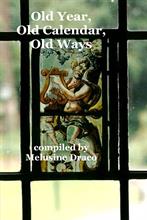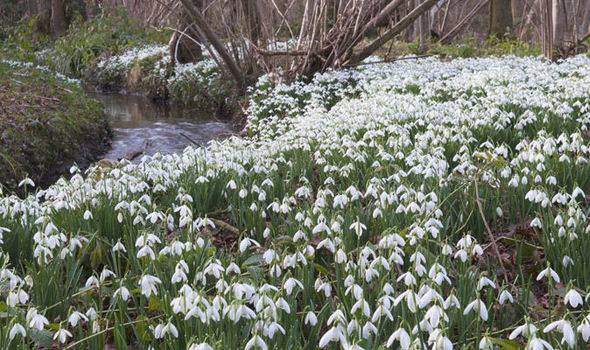
by Carrie West
Since the Victorian era, it is customary to remove Yuletide decorations on Twelfth Night ... but up until the 19th century people would keep their decorations up until Candlemas Eve on 1st February. If this custom wasn’t followed, it was believed that greenery would not return and vegetation would not grow, leading to agricultural shortages and subsequently food problems. Even though Christmas decorations are now less about foliage and more about baubles, glitter and tinsel, many people still adhere to the superstition which they ascribe to the modern Twelfth Night on the 5th January. This 17th century poem by Robert Herrick gives us a better idea of what sort of greenery was used prior to the introduction of the Victorian Christmas tree … In his ‘Ceremony Upon Candlemas Eve’ he wrote …
DOWN with the rosemary, and so
Down with the bays and misletoe ;
Down with the holly, ivy, all,
Wherewith ye dress'd the Christmas Hall :
That so the superstitious find
No one least branch there left behind :
For look, how many leaves there be
Neglected, there (maids, trust to me)
So many goblins you shall see.
In fact, Herrick (1591-1674) wrote at least four poems concerning Candlemas. Likewise, ‘Upon Candlemas Day’ shows the day itself had its own traditions:
END now the white loaf and the pie,
And let all sports with Christmas die.
Finally, in ‘The Ceremonies for Candlemas Day’, he wrote:
KINDLE the Christmas brand, and then
Till sunset let it burn ;
Which quench'd, then lay it up again
Till Christmas next return.
Part must be kept wherewith to tend
The Christmas log next year,
And where 'tis safely kept, the fiend
Can do no mischief there.
This latter poem recalls the tradition that Christmas greenery would be burned and the Yule log allowed to burn down completely, but that a portion should be held back to start next year’s Yule log fire (and as a good luck charm against ‘mischief’). The ashes were to be spread over the garden to ensure a good harvest and the Yule log for the next year would be chosen then. Candlemas was also believed to be a good day for weather forecasting (it falls halfway between the Winter Solstice and the Spring Equinox): If it was a sunny day, there would be forty more days of cold and snow. This belief has carried into folklore tradition around the world, and one olde English rhyme says:
If Candlemas Day be fair and bright,
Winter will have another flight;
But if it be dark with clouds and rain,
Winter is gone, and will not come again.
All this Christian overlay merely confirms what an important festival this was for our pagan forebears and, as such it became the feast of the Purification of the Virgin Mary in the church calendar. The convenience of having yet another pagan festival falling within the ‘nativity cycle’ meant that Brigid became a Catholic saint! In the early calendar, on that morning, many candles were lit in the church, symbolically driving out the darkness. In the afternoon, there was feasting all round, with much music as Candlemas Day (2nd February) marked the formal end of winter.
In the pagan Celtic world it is Imbolc, the festival marking the beginning of spring that has been celebrated since ancient times. It is also a cross quarter day, midpoint between the Winter Solstice and the Spring Equinox, and the name derives from the Old Irish imbolg meaning ‘in the belly’, a time when sheep began to lactate, their udders filled and the grass began to grow. Imbolc was a time to celebrate the Celtic goddess Brigid, goddess of inspiration, healing, and smithcraft, with associations to fire, the hearth and poetry. Là Fhèill Brìghde, is also the day the Cailleach gathers her firewood for the rest of the winter. Legend has it that, if she intends to make the winter last a good while longer, she will make sure the weather on 1st February is bright and sunny, so she can gather plenty of firewood to keep herself warm in the coming months.
Candlemas, then, is the re-awakening of the Old Lass and also coincides with the Roman Festa Candelarum, which commemorated the search for Persephone by her mother Demeter, Persephone having been kidnapped by the King of the Otherworld, Hades The festival of candles symbolizes the return of the Light.
During medieval times, peasants still carried torches and crossed the fields in procession, praying for purification of the ground before planting. In the early churches, the torches were replaced by blessed candles whose glow was supposed to take away evil; villagers and townsfolk would take the candles to their houses to bring protection to their homes and family. During the evening, an especially large candle would have been lit while the family gathered around ready for a feast, during which plans and promises to be kept through the new season would be discussed and debated until it burned out. It was also customary at sunset to ritually light a candle in each room of the home in honour of the Sun’s return. Not surprisingly, in 1543, Thomas Cranmer, Archbishop of Canterbury, banned candles on Candlemas Day because the rites were seen as superstitious, i.e. pagan!
In Old Craft, however, Old Candlemas/Old Imbolc now falls on the 15th February due to the change in the calendar. Imbolc is mentioned in some of the earliest Irish literature and there is evidence it has been an important date since pre-Christian times: at the Mound of the Hostages on the Hill of Tara the rising sun at Imbolc illuminates the inner chamber; the sun also illuminates the chamber at Samhain.
From these ancient rites we can see how they identify with the Old Lass and her awakening, not to mention their association with the Mysteries of Old Craft. In Witchcraft: A Tradition Renewed, Evan John Jones acknowledges that Candlemas is the first of the great Sabbats and the start of the ritual year, when it is time to let go of the past and to look to the future, clearing out the old, making both outer and inner space for new beginnings. In ancient Rome, on the eve of Candlemas all the home fires would have been put out, cleaned out, and re-lit being symbolic of the returning light of the Sun. In Old Craft, and in keeping with this symbolism, a broom made from the three sacred woods symbolic of the three-fold aspects of the goddess (the handle from ash, the brush from birch twigs and the binding cord from willow) would be placed by the front door to symbolize sweeping out the old and welcoming in the new.
But, as Melusine Draco explained in Seeking the Primal Goddess, generally speaking, Old Craft witches prefer not to associate our deities with any dubious mythology – home-grown or foreign import – instead we refer to them obliquely as the Old Ones, the Owd Lad and Owd Lass, the Lord and Lady, or just Him and Her because in truth they are the Nameless God and the Faceless Goddess.
For many people worldwide, Candlemas has a particular smell: not just the scent of lighted candles but also the fragrance of pancakes being cooked for family and friends. Candlemas pancakes should traditionally be made with wheat flour from the previous harvest. Stacks of them could be prepared without fear of famine, since the fields would soon be regaining their golden colour. There was even an old saying that held if you ate pancakes on Candlemas Day, you would be ensured a good harvest in the coming year. What better idea for tonight’s feast than store-bought sweet pancakes and crêpes for convenience?
Though la Chandeleur, Fête de la Lumière or Jour des crêpes is often associated with the French Catholic holiday of Candlemas, this also stems from earlier pagan traditions. While some say Chandeleur celebrates the return of sunny days (crêpes symbolize the sun), others say that making crêpes using flour left over from the harvest ensures prosperity in the coming year.
Store-bought crêpes can be warmed in the oven while the Sabbat ritual is in progress. Set the oven to its lowest temperature and layer the cold crêpes with wax paper between them, then wrap the entire stack in wax paper. Wrap the whole bundle with foil, and leave it in the oven at the lowest setting for one to one and a half hours until thoroughly warmed through. Not as enjoyable as good old-fashioned home-made ones, admittedly, but not as time-consuming, especially if it’s a full Coven-meeting – which it should be on this very special night when the Old Lass re-awakens because it welcomes her back.
The floral tributes for Candlemas are those early favourite spring flowers – snowdrops – despite them not being native to the British Isles. They’re actually from southern Europe and only came to Britain in the late 16th century, and it took them almost 200 years to become a naturalized wild plant. Seeing snowdrops pop up is one of the first signs that spring is on the way and, since they’re supposed to bloom at Candlemas, they’re also known as ‘Candlemas bells’. But native to our islands or not, who doesn’t seek for signs of them in gardens, parks and churchyards on a fine spring day as the first grey-green spears of foliage push through the frosty earth? A small bunch or pot of snowdrops by the door to welcome the guests, perhaps …

 RSS Feed
RSS Feed